2020 Zandvoort Historic Grand Prix report report
Miracle in the dunes
Author
- Mattijs Diepraam
Date
- September 28, 2020
Related articles
- Zandvoort - The quintessential GP track in the dunes, by Mattijs Diepraam
- Zandvoort - Historic crowd-puller, 2012 Historic GP report, by Mattijs Diepraam
- Zandvoort - Treasure in the dunes, 2013 Historic GP report, by Mattijs Diepraam
- Zandvoort - Seaside sensations, 2014 Historic GP report, by Mattijs Diepraam
- Zandvoort - Lucky stars, 2015 Historic GP report, by Mattijs Diepraam
- Zandvoort - Down to the wire, 2016 Historic GP report, by Mattijs Diepraam
- Zandvoort - Dune tragedy, 2017 Historic GP report, by Mattijs Diepraam
- Zandvoort - Epic sand fights, 2018 Historic GP report, by Mattijs Diepraam
- Zandvoort - The boys were back in town, 2022 Historic GP report, by Mattijs Diepraam
- Zandvoort - Sunscreen, umbrellas and heated racing action, 2023 Historic GP report, by Mattijs Diepraam
- Zandvoort - Close contests, 2024 Historic GP report, by Mattijs Diepraam
- Zandvoort - Pass the Dutchie on the left-hand side, 2025 Historic GP report, by Mattijs Diepraam
Who?Steve Brooks What?Lotus-Cosworth 81 Where?Zandvoort When?2020 Historic Grand Prix (September 4, 2020) |
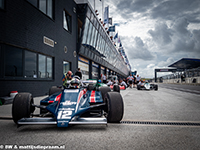 |
Why?
In a 2020 historic motorsport calendar blighted by postponements and cancellations, the Historic Grand Prix at Zandvoort proved to be a true miracle. It took place on the original date, and a crowd was present too – which had to adhere to strict social-distancing rules but wasn’t forced to wear face protection. Half of the original programme was slashed due to the UK’s strict quarantine measures but fortunately four Masters grids did arrive from England and the rest of Europe, adding up to three national grids and four grids from Germany that saved the show. Let’s look at what happened.
Who could have predicted the events of 2020 as they unfolded upon an increasingly incredulous world population? Certainly not the calendar makers of the manifold motorsport calendars that were painstakingly puzzled out during 2019 and into that happy and carefree winter of 2020. Then came March, and suddenly the Covid-19 pandemic held the world by its throat. Zandvoort’s Historic Grand Prix being scheduled in early September, everything looked fine and dandy until summer approached. The curve had been flattened in most countries but the UK was maintaining and even re-introducing strict quarantining for Britons returning home as well as overseas tourists and workers arriving in Britain. This hurt British-based international historic racing unevenly hard, as British teams were unable to leave the UK while drivers from the continent – and also the continental media involved in historic racing – were effectively prohibited from coming over.
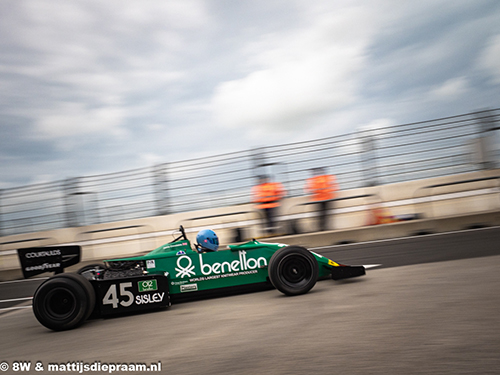
Jamie Constable's Tyrrell 011 didn't make it past qualifying, and the Briton switched to his Shadow DN8 for the races. (photo 8W)
As the Zandvoort date drew closer, the HSCC and HGPCA withdrew their 1000cc F3, F2 and pre-’66 F1 grids, which were rapidly replaced by the German FHR and its multitude of grids, as well as the Kampf der Zwerge series for small-sized touring cars of the sixties and seventies. The event was then salvaged when Masters Historic Racing was able to obtain a quarantine exemption from Motorsport UK for both Zandvoort and the Spa Six Hours, with Motor Racing Legends handed a similar reprieve for the latter late-September event. In the end, the Spa exemption was rendered moot when the Six Hours were cancelled on the Friday of the Historic Grand Prix, but at least Zandvoort was go.
With Holland’s aversion to facemasks – a national tendency the country has in common with the UK – the event soon felt like a club meeting from the old days, with enough people around for the place not to be feel uninhabited but with enough space to comply with the necessary social distancing. Apart from the homely feeling, the foreign teams and competitors were keen on sampling the newly renovated track as was readied for the 2021 Dutch GP. Its original comeback Grand Prix postponed for a year, completion had been going at a slower pace, so the circuit still wasn’t the full-fledged 21st-century Grand Prix track that it’s now meant to be, but at least the track was there – with its two new, challenging banked turns 3 and 14, better known to the locals as the Hugenholtzbocht (named after Zandvoort’s first circuit director and later designer of tracks such as Suzuka and Jarama) and the Arie Luyendijkbocht (with its Indy gradient and SAFER barrier at the top now more aptly named than before). In fact, the Historic Grand Prix would be the first occasion in which F1 cars would test the new circuit – and when the weekend was done, Mike Cantillon’s 1.31.977 was celebrated as the official lap record of the new layout, set in the Irishman’s Williams FW07C in the same weekend that at Monza the Williams family said goodbye to their team.
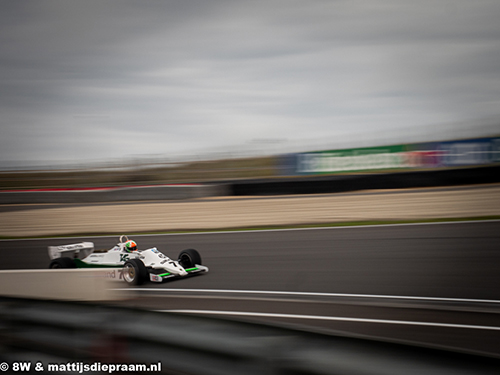
Mike Cantillon is Zandvoort's new lap-record holder. (photo 8W)
Cantillon stormed both Masters Historic Formula One races – non-FIA, as was the Masters Historic Sports Car race, as FIA status had meant that both grids, as well as the one-off FIA Historic Formula 3 European Cup, would have had to adhere to FIA Appendix S regulations introduced for modern motorsport to face the challenge of safe and healthy motor racing in the Covid-19-afflicted 2020 season. This included pre-event testing and separate bubbles for each grid. As historic motorsport is about fun more than about winning, the idea was soon rejected by the competitors, which resulted in cancellation of the F3 Cup and non-FIA status for both Masters grids. Marco Werner’s Lotus 77 was Cantillon’s main rival in both races, the double pre-78 class winner successfully fending off the post-78 cars of Steve Brooks (Lotus 81) and Mark Hazell (Williams FW08). Sadly, the F1 races were robbed of its main attraction, Jonathan Holtzman’s amazing Tyrrell P34 continuation, as the American was stuck at home and unable to fly over to Europe. The car was handed to Matt Wrigley for a pair of demo laps on Saturday and Sunday, but that was it.
Because of the HSCC and HGPCA’s absence and the FIA F3 Cup being called off, the single-seaters’ only other representation came from the Dutch-based Historic Monoposto Racing grid, mainly consisting of Formula Ford 1600 and 2000 cars up to 1981 with additions from the F3 and F (Super) Vee categories. On Saturday, Marcel Biehl drove off to a dominant win in his F3 Ralt RT1 but when the German retired from race 2, reigning champion Kees van der Wouden struck gold in his FF2000 Royale RP30.
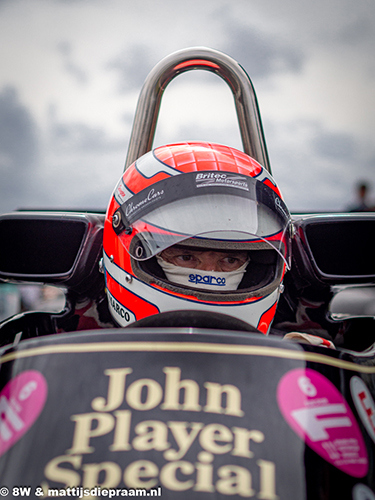
Marco Werner was Cantillon's closest rival. (photo 8W)
Masters Historic Sports Cars topped the sportscar bill but only just, as it brought a grid of just ten cars, while FHR’s 100 Meilen Trophy competed with a grid headed by a handful of big-banger early-seventies sportscars. The Masters’ ten were of good quality, though, with Manfredo Rossi’s Osella-Abarth PA1 and Mike Wrigley’s Chevron B19 taking on a bunch of Lola T70 Mk3Bs. There was no stopping one of those, as local heroes David Hart and Nicky Pastorelli romped home to a popular victory. In fact, it would a perfect Sunday for Hart, as he also shared the Aston Martin Masters Endurance Legends race 2-winning Maserati MC12 (again with Pastorelli) while also claiming Masters Gentlemen Drivers honours in his Bizzarrini 5300 GT (sharing with son Olivier).
In Aston Martin Masters Endurance Legends, Pastorelli only led for the final stretch, passing the Karl Pedraza/Philippe Papin ORECA-Nissan 03 with one corner to go. It should have been a double for Jack Dex in the BR Engineering BR01 that easily cornered race 1 glory but a huge 3-minute stop-and-go penalty issued by a seriously miffed race director for what was undoubtedly a very unsafe release at the mandatory pitstops threw Dex out of contention for the repeat win.
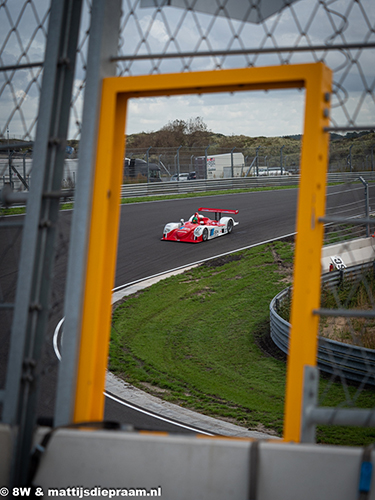
Sadly, Christophe d'Ansembourg's ex-Didier Theys Doran-Lista Dallara-Judd SP1 DO-05 didn't make it past AMMEL practice. (photo 8W)
The Masters Gentlemen Drivers’ two-horse race was robbed of a horse when the pole-sitting Shelby Cobra Daytona Coupé started by Nigel Greensall was hit by a puncture two laps into Mark Martin’s closing stint. Martin had already given up time to the home favourites with a HANS-related issue during the Daytona Cobra’s pitstop, leaving Olivier Hart to conquer the lead and the eventual win just moments after Martin’s pit exit. Young Olivier then completed an untroubled run to the finish in the Bizzarrini shared with father David. The minnow C1-class Porsche 904/6 GTS of Dutchmen Michiel van Duijvendijk and Pascal Pandelaar took a stunning second place overall, courtesy of Pandelaar’s magic pace in the second half of the race. The Porsche finished ahead of the CLP-class-winning Lotus Elan of Sander van Gils, who completed an all-Dutch podium.
The 100 Meilen Trophy races proved humdingers both. In the first, Georg Hallau’s CanAm Lola T310 chased Felix Haas hard all race before Haas’ T294 succumbed to a puncture five minutes from the end. The pair had left Peter Schleifer’s mighty McLaren M8F in their wake, but the next day Schleifer upped his game, resulting in the spectacle of the two CanAm cars swapping the lead at least six times before Hallau prevailed.
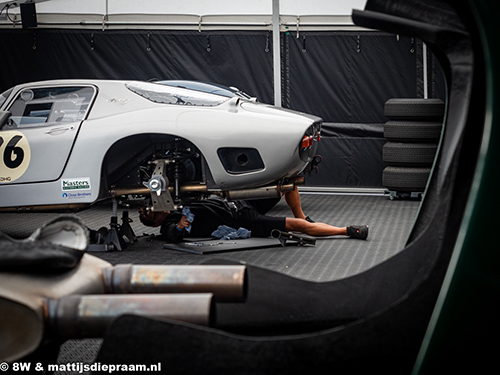
This Bizzarrini 5300 GT gave David Hart one of three victories on a very successful Sunday. (photo 8W)
Haas made the 2-hour Dunlop Historic Endurance Cup race his own on Sunday afternoon, winning by the huge margin of four laps over the Shelby Mustang GT350 of the Belgian Devis brothers. The Escort Mk1 RS1600 pair in third, Heinz Schmersal and Mike Stursberg, hauled their Mk2 RS1800 to NK GTTC glory in the Dutch ’66-’81 championship’s first race on Saturday, heading series regular Hans de Graaf whose Porsche 911 Carrera RS won the next day. Schmersal and Stursberg also won the German HTGT race that for one hour ran concurrently with the Dunlop Historic Endurance Cup weekend closer.
The HARC NK 82-90 went off to a false start when the pole-sitting Ford Sierra Cosworth RS500 of Belgian Jan van Elderen took off after the safety car on its inspection lap, the rest of the field following suit. Van Elderen’s Eggenberger-liveried machine duly won the first race but faltered two laps into the second, handing the win to Sander den Dekker’s Porsche 944.
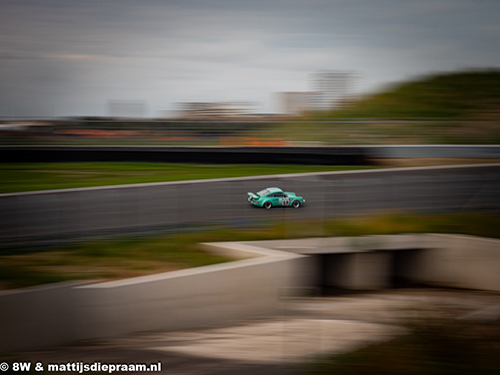
Hans de Graaf's Porsche Carrera RS storming the Arie Luyendijkbocht. (photo 8W)
And finally, five Kampf der Zwerge divisions fought it out to prove who owned the best NSU TT, Fiat Abarth, Mini Cooper, Hillman Imp or any French Renault, Simca or Alpine up to 1300cc, as over 40 of them ran in four separate 30-minute sessions. In the end, Herbert Wein Jr’s Mini Cooper Mk2 was quickest on both days, followed home by the TTs of Andreas Vielgut and Alex Schneider.
